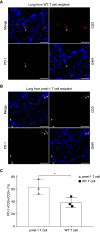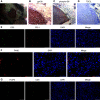Adoptive T-Cell Transfer to Treat Lymphangioleiomyomatosis
- PMID: 32078336
- PMCID: PMC7710336
- DOI: 10.1165/rcmb.2019-0117OC
Adoptive T-Cell Transfer to Treat Lymphangioleiomyomatosis
Abstract
Patients with lymphangioleiomyomatosis (LAM) develop pulmonary cysts associated with neoplastic, smooth muscle-like cells that feature neuroendocrine cell markers. The disease preferentially affects premenopausal women. Existing therapeutics do not cure LAM. As gp100 is a diagnostic marker expressed by LAM lesions, we proposed to target this immunogenic glycoprotein using TCR transgenic T cells. To reproduce the genetic mutations underlying LAM, we cultured Tsc2-/- kidney tumor cells from aged Tsc2 heterozygous mice and generated a stable gp100-expressing cell line by lentiviral transduction. T cells were isolated from major histocompatibility complex-matched TCR transgenic pmel-1 mice to measure cytotoxicity in vitro, and 80% cytotoxicity was observed within 48 hours. Antigen-specific cytotoxicity was likewise observed using pmel-1 TCR-transduced mouse T cells, suggesting that transgenic T cells may likewise be useful to treat LAM in vivo. On intravenous injection, slow-growing gp100+ LAM-like cells formed lung nodules that were readily detectable in severe combined immunodeficient/beige mice. Adoptive transfer of gp100-reactive but not wild-type T cells into mice significantly shrunk established lung tumors, even in the absence of anti-PD-1 therapy. These results demonstrate the treatment potential of adoptively transferred T cells to eliminate pulmonary lesions in LAM.
Keywords: T cell receptor; adoptive T cell transfer; gp100; lymphangioleiomyomatosis.
Figures







Comment in
-
"T"eeing Up A Novel Therapy for Lymphangioleiomyomatosis.Am J Respir Cell Mol Biol. 2020 Jun;62(6):678-680. doi: 10.1165/rcmb.2020-0049ED. Am J Respir Cell Mol Biol. 2020. PMID: 32101457 Free PMC article. No abstract available.
References
-
- Johnson SR, Taveira-DaSilva AM, Moss J. Lymphangioleiomyomatosis. Clin Chest Med. 2016;37:389–403. - PubMed
Publication types
MeSH terms
Substances
Grants and funding
LinkOut - more resources
Full Text Sources
Molecular Biology Databases
Research Materials

